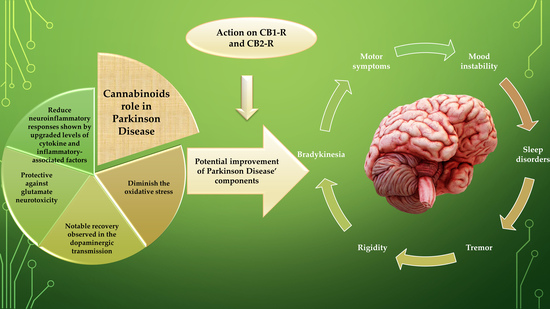 “Cannabidiol (CBD) is a non-psychoactive phytocannabinoid known for its beneficial effects including antioxidant and anti-inflammatory properties. Moreover, CBD is a compound with antidepressant, anxiolytic, anticonvulsant and antipsychotic effects. Thanks to all these properties, the interest of the scientific community for it has grown.
“Cannabidiol (CBD) is a non-psychoactive phytocannabinoid known for its beneficial effects including antioxidant and anti-inflammatory properties. Moreover, CBD is a compound with antidepressant, anxiolytic, anticonvulsant and antipsychotic effects. Thanks to all these properties, the interest of the scientific community for it has grown.
Indeed, CBD is a great candidate for the management of neurological diseases. The purpose of our review is to summarize the in vitro and in vivo studies published in the last 15 years that describe the biochemical and molecular mechanisms underlying the effects of CBD and its therapeutic application in neurological diseases.
CBD exerts its neuroprotective effects through three G protein coupled-receptors (adenosine receptor subtype 2A, serotonin receptor subtype 1A and G protein-coupled receptor 55), one ligand-gated ion channel (transient receptor potential vanilloid channel-1) and one nuclear factor (peroxisome proliferator-activated receptor γ). Moreover, the therapeutical properties of CBD are also due to GABAergic modulation.
In conclusion, CBD, through multi-target mechanisms, represents a valid therapeutic tool for the management of epilepsy, Alzheimer’s disease, multiple sclerosis and Parkinson’s disease.”

 “Current pharmacotherapy of Parkinson’s disease (PD) is symptomatic and palliative, with levodopa/carbidopa therapy remaining the prime treatment, and nevertheless, being unable to modulate the progression of the neurodegeneration. No available treatment for PD can enhance the patient’s life-quality by regressing this diseased state.
“Current pharmacotherapy of Parkinson’s disease (PD) is symptomatic and palliative, with levodopa/carbidopa therapy remaining the prime treatment, and nevertheless, being unable to modulate the progression of the neurodegeneration. No available treatment for PD can enhance the patient’s life-quality by regressing this diseased state.
 “In the last few years research into Cannabis and its constituent phytocannabinoids has burgeoned, particularly in the potential application of novel cannabis phytochemicals for the treatment of diverse illnesses related to neurodegeneration and dementia, including Alzheimer’s (AD), Parkinson’s (PD) and Huntington’s disease (HD). To date, these neurological diseases have mostly relied on symptomatological management. However, with an aging population globally, the search for more efficient and disease-modifying treatments that could delay or mitigate disease progression is imperative. In this context, this review aims to present a state of art in the research with cannabinoids and novel cannabinoid-based drug candidates that have been emerged as novel promising alternatives for drug development and innovation in the therapeutics of a number of diseases, especially those related to CNS-disturbance and impairment.”
“In the last few years research into Cannabis and its constituent phytocannabinoids has burgeoned, particularly in the potential application of novel cannabis phytochemicals for the treatment of diverse illnesses related to neurodegeneration and dementia, including Alzheimer’s (AD), Parkinson’s (PD) and Huntington’s disease (HD). To date, these neurological diseases have mostly relied on symptomatological management. However, with an aging population globally, the search for more efficient and disease-modifying treatments that could delay or mitigate disease progression is imperative. In this context, this review aims to present a state of art in the research with cannabinoids and novel cannabinoid-based drug candidates that have been emerged as novel promising alternatives for drug development and innovation in the therapeutics of a number of diseases, especially those related to CNS-disturbance and impairment.” “Parkinson’s Disease (PD) is currently the most rapid growing neurodegenerative disease and over the past generation, its global burden has more than doubled. The onset of PD can arise due to environmental, sporadic or genetic factors. Nevertheless, most PD cases have an unknown etiology.
“Parkinson’s Disease (PD) is currently the most rapid growing neurodegenerative disease and over the past generation, its global burden has more than doubled. The onset of PD can arise due to environmental, sporadic or genetic factors. Nevertheless, most PD cases have an unknown etiology. “The antioxidant and CB2 receptor agonist properties of Δ9-tetrahydrocannabivarin (Δ9-THCV) afforded neuroprotection in experimental Parkinson’s disease (PD), whereas its CB1 receptor antagonist profile at doses lower than 5 mg/kg caused anti-hypokinetic effects.
“The antioxidant and CB2 receptor agonist properties of Δ9-tetrahydrocannabivarin (Δ9-THCV) afforded neuroprotection in experimental Parkinson’s disease (PD), whereas its CB1 receptor antagonist profile at doses lower than 5 mg/kg caused anti-hypokinetic effects. “Cannabis sativa, commonly known as marijuana, contains a pool of secondary plant metabolites with therapeutic effects.
“Cannabis sativa, commonly known as marijuana, contains a pool of secondary plant metabolites with therapeutic effects. “Parkinson’s disease (PD) is a neurodegenerative disorder characterized by the degeneration of the nigrostriatal dopaminergic pathway with loss of substantia nigra pars compacta neurons and dopamine depletion. Various natural compounds showed protective actions against PD.
“Parkinson’s disease (PD) is a neurodegenerative disorder characterized by the degeneration of the nigrostriatal dopaminergic pathway with loss of substantia nigra pars compacta neurons and dopamine depletion. Various natural compounds showed protective actions against PD. “Generally, the development and progression of neurodegenerative diseases are associated with advancing age, so they are usually diagnosed in late adulthood. A primary mechanism underlying the onset of neurodegenerative diseases is neuroinflammation. Based on this background, the concept of “neuroinflammaging” has emerged. In this deregulated neuroinflammatory process, a variety of immune cells participate, especially glial cells, proinflammatory cytokines, receptors, and subcellular organelles including mitochondria, which are mainly responsible for maintaining redox balance at the cellular level. Senescence and autophagic processes also play a crucial role in the neuroinflammatory disease associated with aging.
“Generally, the development and progression of neurodegenerative diseases are associated with advancing age, so they are usually diagnosed in late adulthood. A primary mechanism underlying the onset of neurodegenerative diseases is neuroinflammation. Based on this background, the concept of “neuroinflammaging” has emerged. In this deregulated neuroinflammatory process, a variety of immune cells participate, especially glial cells, proinflammatory cytokines, receptors, and subcellular organelles including mitochondria, which are mainly responsible for maintaining redox balance at the cellular level. Senescence and autophagic processes also play a crucial role in the neuroinflammatory disease associated with aging. “Medicinal
“Medicinal  “Activation of
“Activation of